(Written by William)
When the #21334 LEGO Ideas Jazz Quartet model was selected as a winner from one of LEGO Ideas’ contests, I was intrigued. I had recently gotten around to building the #21329 LEGO Ideas Fender Stratocaster from the same contest and thoroughly enjoyed myself. With that said, I probably would not have picked up this set right on release day, but maybe a little later. However, when LEGO offered it as a review copy to theBrickBlogger, I jumped at the chance to check it out.
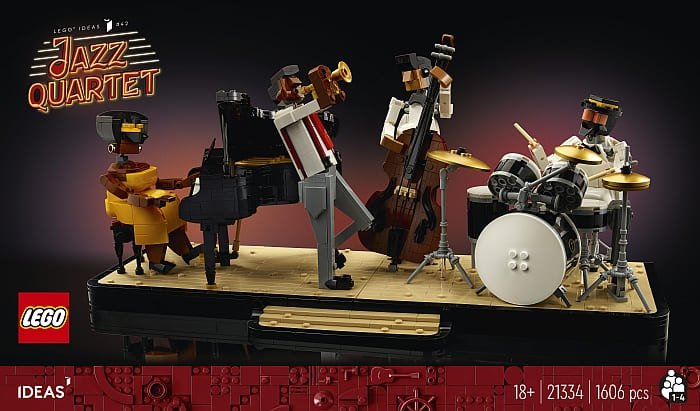
I should point out that this set has a niche appeal. It is much more a piece of art than a toy to play with or a well-known model to display. It ended up being a fantastic building experience. And this experience could even be shared with others, as the set is made up of several separate modules. (I’ll talk more about this later). Overall, I found the model to be unlike anything else I’ve built in recent memory.

In addition to the highly detailed instruments, you also build a number of musicians who are racially diverse. I rather enjoyed that fact since it meshed naturally with the subject matter. It wasn’t forced or even done as a socially charged statement. Instead, it was a message that we can all come together through the love of music.

The real test is whether or not this set fits your own personal style. Can it express what you want out of a model? Well, to answer that, let’s take a look at exactly what this set can do.
LEGO IDEAS JAZZ QUARTET – ARTICULATION
Art pieces like this are usually filled with personality. And of course, this can be increased with additional articulation. Each of the musicians is perfectly posed to capture them in their element. But, how much can this be modified?
Each of the musicians has one point of articulation that is universal; the angle of their head is fully adjustable. The neck is built as a ball and socket connection. This ability to twist and tilt can really give the illusion of how the characters are grooving to the music. Beyond this, the articulation is rather specific to each individual. From what I can tell, the additional posability is directly connected to the instrument they play. Let’s go over each of them in detail.
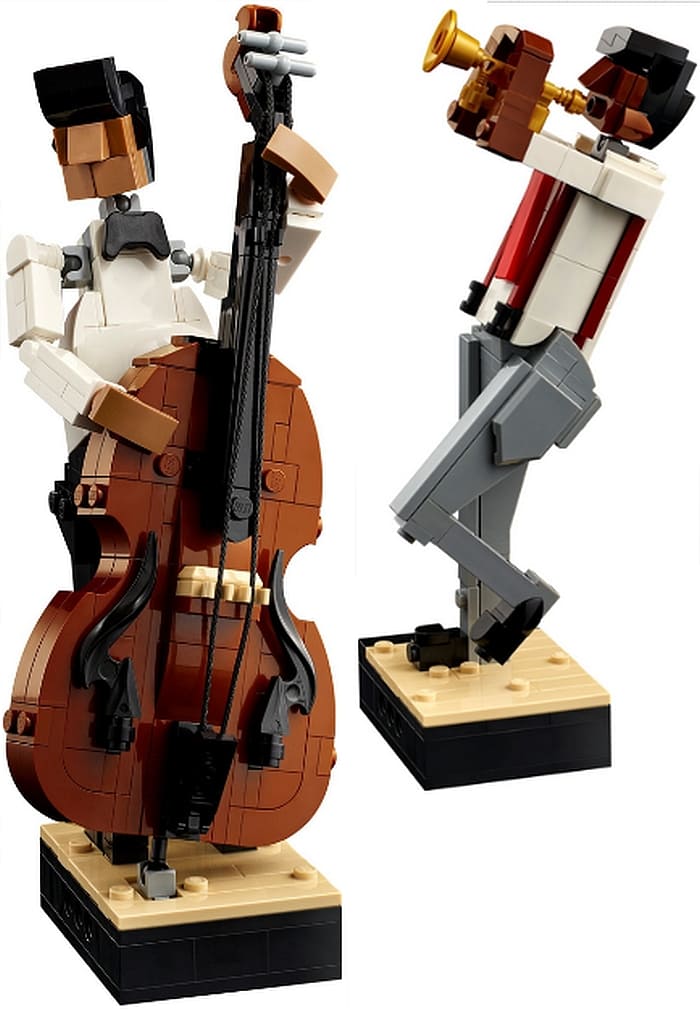
The trumpet player is really belting out a solo. His instrument is the smallest on stage, so doesn’t require additional arm movement. The only point of additional articulation I found was in his waist. It is very minor, however, it does change the angle of his horn so can provide a subtle degree of just how hard he’s playing.
Next up is the bassist. His bass guitar has its own bit of posability. It is anchored onto the stage with a ball-joint. This allows it to be tilted in a wide range of directions. Beyond this, the bassist’s arms have the ability to move around in order to reach the strings. His shoulders are built with ball and socket joints while his elbows are built with clip and bar connections. This gives his arms a wide range of mobility to accommodate the tilting of the bass.
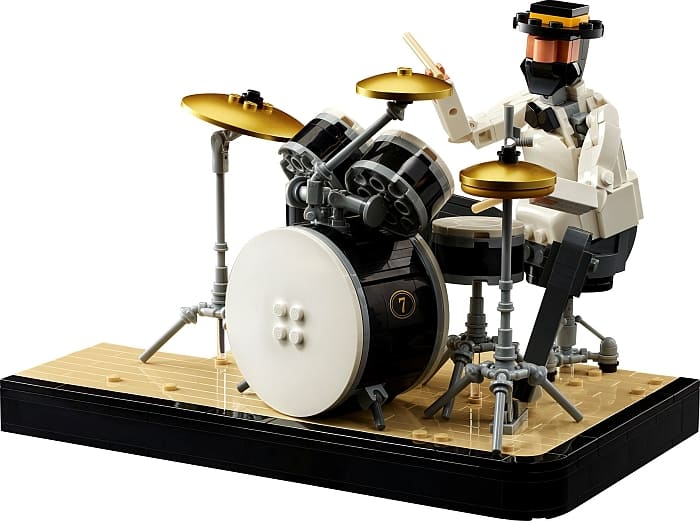
Then there is the drummer. He is sitting on a stool that can rotate so that he can face different sections of his drum kit. His legs are connected in with clips and bars to allow them to swivel left and right. In other words, he can spread his legs to reach the pedals. Then there is his waist. It uses a pin connector to allow the top part of his torso to swivel. So, once you get the right angle with the stool, you don’t need to mess with it since you can simply twist him to reach whatever he needs to reach. His arms are also built on ball-joints which allows a vast range of motion. His elbows though are a bit different. They use a swivel hinge plate so they can move, but a modified tooth plate is used as a restrictor. This means his arms will always be bent to some degree to maintain proper form.
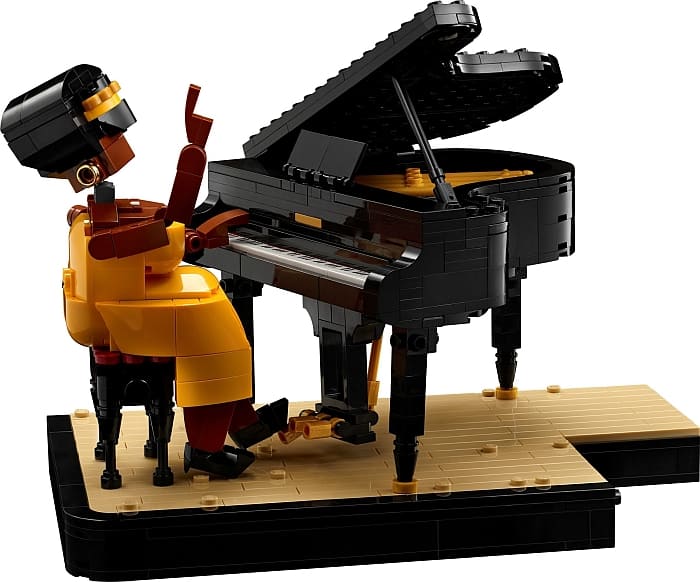
Finally, we move to the pianist. Her requirements for playing involve the use of the foot pedals as well as her hands on the keys. For her feet, just under the hem of her dress are clip and bar connections to allow her feet to move forward and back. Her arms are built on a small bar with rounded plate connectors. The rounded plate portion of this piece allows the arms to angle forward and back. Since the bar is connected to a hollow stud, you can rotate the shoulder as well. Her elbows have a swivel hinge to allow her to lift and lower her forearms. Meanwhile, the hands are connected in with a modified plate with a barrel connector. If you are careful, you can pose her hands up and down letting her flex at the wrist.
Given the fragile nature of some of the characters, much of the posability is reduced in order to have them anchored in properly. The trumpet player and the bassist are actually built into the stage, while the drummer and pianist are supported by their respective seats.
LEGO IDEAS JAZZ QUARTET – COMPARTMENTALIZATION
One thing I love about some of these larger art-type models is how they are compartmentalized. This set in particular comes with five manuals. One is all about the history of jazz and the designers that brought this set to life. The other four each focus on a specific musician and their section of the stage.
The idea is that you could build this set all at the same time with three other friends or break up your building experience one note at a time. Once you are done, the stage will fit together modularly and create your jazz quartet.
LEGO designers also made the bassist and trumpet player’s sections interchangeable. By swapping a few pins around you can reposition the trumpet player in the back and move the bassist forward. It’s a tiny detail that’s just nice to have. Of course, you don’t need to have the stage connected at all. This model then gives you four distinct musicians that can fit one person’s passion.
LEGO IDEAS JAZZ QUARTET – THE INSTRUMENTS
As nice as the musicians are, it doesn’t feel like they are the main focus of all the detail work. The real stars are the instruments themselves. Building the set starts off slow with the trumpet, and with each additional piece, the instruments become more and more elaborate.
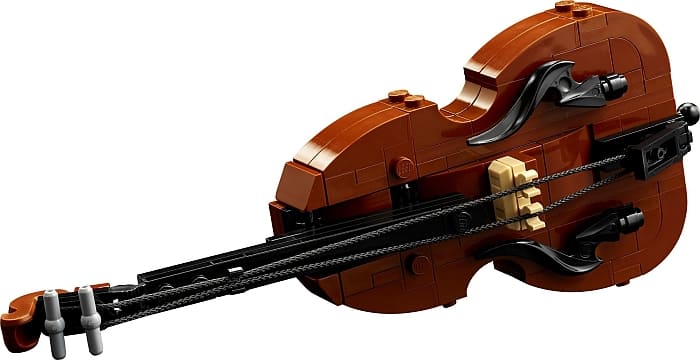
Being the smallest instrument, it is easy to overlook the trumpet. Though it is wonderfully shaped with its fluted opening and delicate handles. Meanwhile, the bass deepens the experience by featuring interesting angles to the neck and head, strings, and some clever detail work located on the body of the bass. Then the model hits a new level.
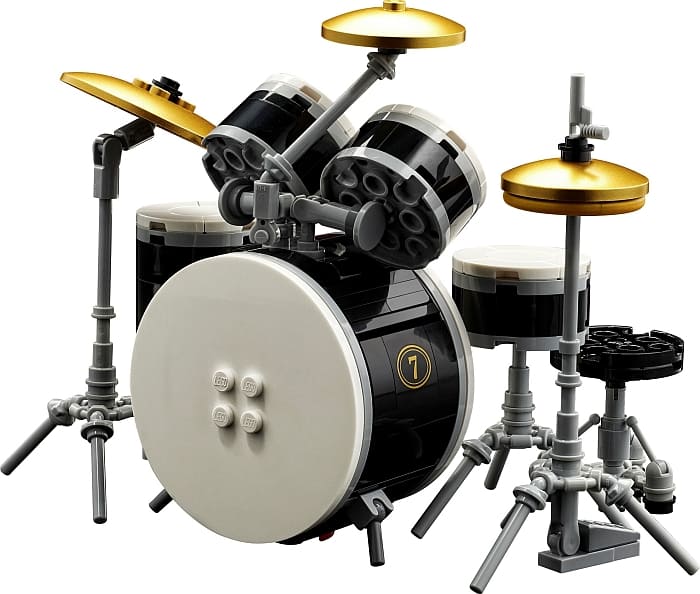
The drum kit is absolutely stunning. From the stands to the symbols, this kit is one of the most complete drum sets I’ve ever seen built out of LEGO bricks. The attention to how the drums are angled to the tiny legs that help stabilize the big bass drum at the bottom just speak to how familiar the designers were with recreating the drums. I couldn’t imagine this set getting this detailed or how it could possibly follow up. And then it proved me wrong.
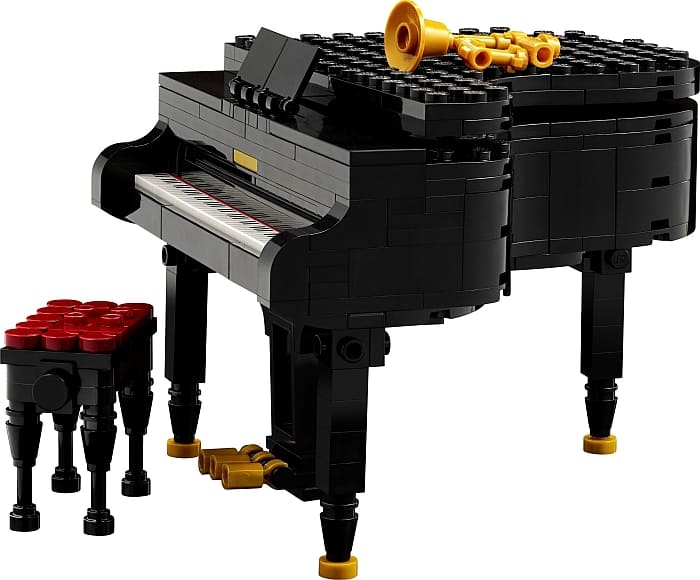
I’ve built the #21323 LEGO Ideas Grand Piano set. It went above and beyond capturing the fine details found in real pianos. I wasn’t expecting this set to essentially do the same, just on a smaller scale. Sure, it doesn’t really work like the larger version, but all the important elements were there; pedals below the piano that can be positioned, grill tiles to recreate all the piano strings, tiles with printed keys for the right number of keys on a piano this size. And if all that wasn’t enough, you stack 31 little plate and bar pieces, and lay them down sideways, which recreates the hammers that strike the strings from underneath. Throw in a quilted bench, music stand, and small details to add accenting, and you got a great way to end a very satisfying build.
LEGO IDEAS JAZZ QUARTET – FINAL THOUGHTS
Honestly, there’s no getting around the fact that this is a niche model. It is definitely made for music fans, musicians, and especially those who love jazz. The angular aesthetic of the musicians can put some people off as well. However, as I mentioned before, the real stars are the instruments.
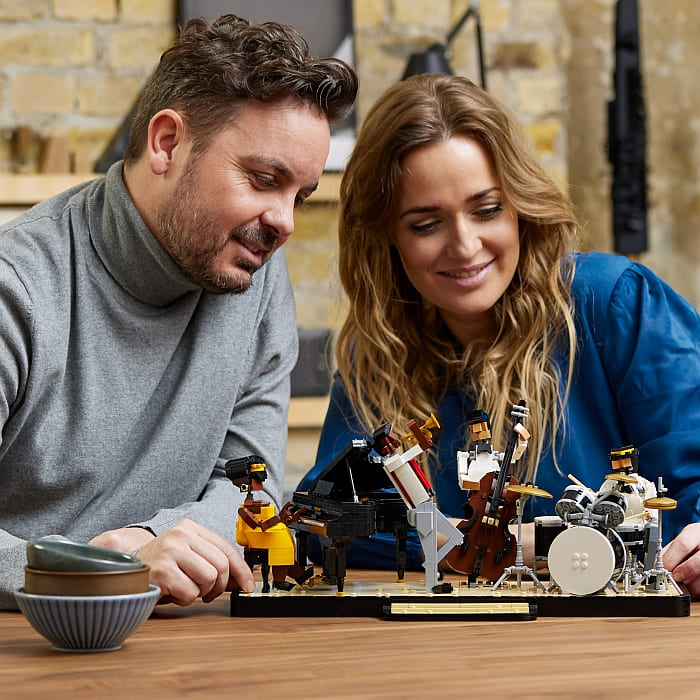
Each musician is built as a caricature of themselves. This is done extremely well since any more details would probably creep people out. Additionally, I think their long frames are mostly to scale properly with the instruments. Again, this is to highlight what they are playing.
Part-wise, this set is a solid parts-pack. The stage alone gives you so much in the way of tan tiles. And the instruments provide a wealth of curved elements that are extremely useful. It’s also worth noting that all the decorated parts you see are printed. This includes a couple of slopes with “7” on them for the drums and all the keys of the piano. I’m not sure if the price increase LEGO has announced will change the price of this model in the future, but $100 USD is a good price for the parts you get.
As for the collectability of the set, this should be modestly valuable. I can’t see it getting too many print runs, plus it is not connected to intellectual property, but it is a unique build. In short, a jazz fan will always find this interesting while a builder will always have a great time with the model.
Ultimately, the ideal customer for this set is probably the family that loves music. Right out of the box four people can start building. Add in the loving details of each instrument, I can imagine this leading straight into a jam session. Because everyone knows, a family that plays together should build together! The #21334 LEGO Ideas Jazz Quartet set will be available starting on July 1st at the LEGO Ideas section of the Online LEGO Shop.
What do you think? How do you like the new LEGO Ideas Jazz Quartet set? And what do you think of the interesting building techniques? Feel free to share your thoughts and discuss in the comment section below!
And you might also like to check out the following related posts:












Thanks for the informative review. I’m not a big fan of the figures, but I like the instruments. Especially the drums. So good! 🤗
I don’t like the fact that they made the trumpet player’s legs of various widths, so he looks rather unbalanced. Perhaps it was due to stability, but I found the original design more elegant (even if it lacked a woman).